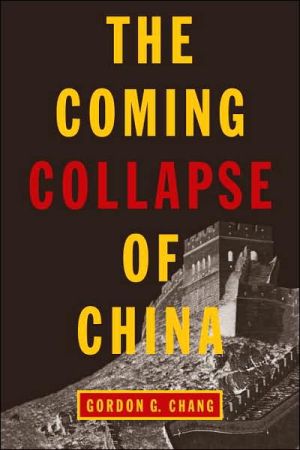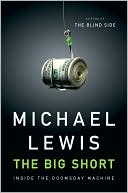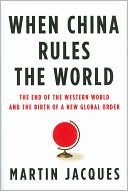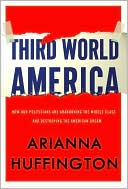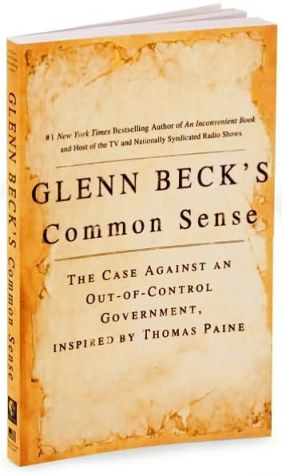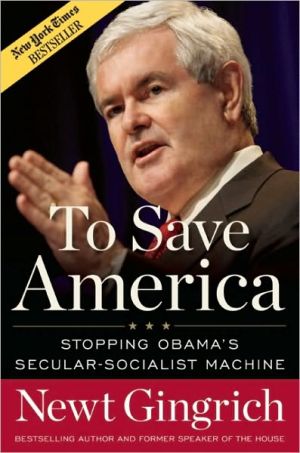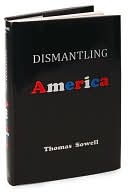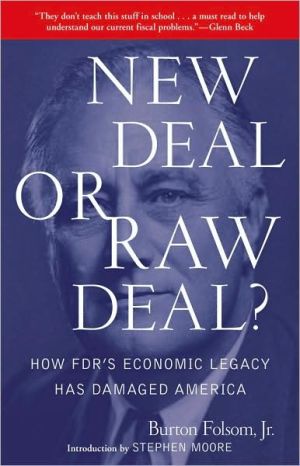The Coming Collapse of China
China is hot. The world sees a glorious future for this sleeping giant, three times larger than the United States, predicting it will blossom into the world's biggest economy by 2010. According to Chang, however, a Chinese-American lawyer and China specialist, the People's Republic is a paper dragon. Peer beneath the veneer of modernization since Mao's death, and the symptoms of decay are everywhere: Deflation grips the economy, state-owned enterprises are failing, banks are hopelessly...
Search in google:
China is hot. The world sees a glorious future for this sleeping giant, three times larger than the United States, predicting it will blossom into the world's biggest economy by 2010. According to Chang, however, a Chinese-American lawyer and China specialist, the People's Republic is a paper dragon. Andrew J. Nathan Damning data and persuasive arguments that should set some Communist knees a-knocking. miracle,KirkusGordon Chang takes us on a vividly observed voyage behind the scenes of China's so-called economic
1\ The Dinner Party\ The Revolution Has Grown Old\ [A] revolution is not a dinner party, or writing an essay, or painting a picture, or doing embroidery; it cannot be so refined, so leisurely and gentle, so temperate, kind, courteous, restrained and magnanimous. A revolution is an insurrection, an act of violence by which one class overthrows another.\ —mao zedong They will move Mao Zedong’s body soon; it lies on hallowed ground. When the Communist Party of China falls, when the third Chinese revolution succeeds, they will move him from Tiananmen Square, the center of Beijing and the heart of China. So much history has occurred in Tiananmen, and so much more has yet to happen. The People’s Republic was proclaimed there, and there, inevitably, its end will be announced. And when it falls, the people will take Mao’s body from the square to mark a new beginning.\ “We should die fighting,” said Mao. The Party, born of conflict, knows no other way. It will not politely leave when the people demand it; they will have to take back their government by force. Revolution is not a dinner party, Mao informed us, and it’s not gentle, temperate, or kind. It’s an insurrection and an act of violence. And China’s history has set the pattern. Dynasties appear strong, even toward their end. Chinese rulers resist to the last moment, even when it is clear that change must occur. It seems that peaceful evolution is not yet part of this people’s story. The Chinese have endured so much during the past century. If all were fair, this century, the one that has just begun, should be kinder to them. It won’t work out that way, however. “We should die fighting,” Mao said, and that’s just what is going to happen. Their suffering is not over yet.\ So the Communist Party has shown the world that only force will be able to move it. The people are supposed to be intimidated by this colossal display of obstinacy, and, at least for the moment, many are. But they just wait in silence and let their resentments fester. The Party knows how to suppress, but it no longer has the power to lead. It has forgotten what once made it great.\ “The Revolution has become a dinner party,” says Maggie Farley, who has taken Mao Zedong’s quip on revolution and stood it on its head. Her one short sentence summarizes the history of the People’s Republic.\ Both Mao and Farley are correct. Indeed, if Mao could see what has become of his China, he would agree with Farley, a journalist and former resident of Shanghai. Mao, unprompted, might even say the same thing himself. He would, no doubt, utter Farley’s words as a condemnation of the current state of affairs or perhaps as one of his many calls to action. No, revolution is not a dinner party, but there is little that is revolutionary in present-day China. Farley conveys the image of a mass movement institutionalized, something that Mao, who promoted the concept of “continuous revolution,” sought to prevent.\ Today the people no longer want Mao’s revolution or the party that administers it. And so the People’s Republic is going to fall, just like its predecessors. History shows that the Chinese people, once aroused, will not be denied. The Ming and the Qing, the last two imperial dynasties, and Chiang Kai-shek’s Kuomintang, the Nationalists, all fell quickly.\ For the Qing, it was over almost as soon as it began. The Chinese, disgusted by their oppressive and inept rulers, demanded change. Some sought constitutional restraints on imperial power and others wanted revolution, but all knew that the current system had failed China. At the end it took just an incident—and almost any would have sufficed—to trigger rapid collapse. An accidental explosion in October 1911 ended in the abdication, four months later, of Puyi, the six-year-old emperor. With him went a dynasty of more than two hundred years and imperial rule of two thousand. Sun Yat-sen’s Revolutionary Alliance stood triumphant; China, for the first time in its history, had a republican form of government. And for the first time in many decades there was hope.\ China’s troubles had not ended, however. Turmoil followed the first days of Sun’s Republic of China. Disorder resulted in national weakness, which triggered yet another wave of idealism and activism. The Communist Party of China was founded in 1921 in those crosscurrents, and during that time of turbulence the Communists thrived. They espoused the hope of Chinese nationalism and struck a responsive chord in both city and countryside.\ Sun Yat-sen died in 1925, but by then new leaders had already taken his place. Chiang Kai-shek, a general who married a sister of Sun’s widow, succeeded in uniting most of China under Kuomintang rule in the late 1920s. The Kuomintang, the renamed Revolutionary Alliance, and the Communist Party were born of a common Leninist model and throughout their histories have been allies and enemies, creating a confusing tale from the 1920s through the 1940s. They struggled together as allies to unite China and drive out their common enemy, the Japanese, but they also could not help but fight one another. The Kuomintang’s campaign against the Communists, the story of brother against brother, resulted in bitter struggle. At one point, the Communist army faced extinction. Beginning in October 1934 from inland Jiangxi Province, Mao Zedong’s force of 80,000 started a 6,000-mile retreat that took slightly more than a year. When the legendary Long March was over, the army was reduced to a tenth of its original size, but it survived to fight again. Further conflict was inevitable: two Leninist parties could not inhabit the same space.\ During the Second World War, China, briefly united under Chiang Kai-shek, was split into pieces controlled by the Kuomintang, the Japanese, the Communists, the Tibetans, and the Muslims. Chiang’s Kuomintang had failed; the Chinese fear of disunity had come to pass. Chiang could not hold China together, so he did not succeed in leading its people.\ When the end came for the Kuomintang, it came quickly. Chiang Kai-shek had large forces, but Mao had something more important. The ragtag Communist army swept out of the countryside after the Second World War to surround the cities and prevail. The people had had enough of Kuomintang corruption, brutality, and incompetence. In 1949, Chiang’s forces simply disintegrated, falling to the Communists as fast as the Ming Dynasty had to the Qings three centuries earlier. His capital of Nanjing surrendered without resistance. Chiang could only retreat to Taiwan.\ “We the 475 million Chinese people have now stood up and the future of our nation is infinitely bright,” proclaimed Mao Zedong. On October 1, 1949, he would declare the founding of his republic from the Gate of Heavenly Peace, the main entrance to the Forbidden City of the Ming and Qing emperors. And he would make the old imperial capital of Beijing the Communist seat of power. With the exception of Taiwan, Mao would unify China within a year. Decades of internal strife and disunity would come to an end. With the exception of the tiny enclaves of Hong Kong and Macau, foreigners had been removed from Chinese soil. A chapter of humiliation, a period spanning hundreds of years, had closed. Chinese revolutionaries had prevailed for the second time in the twentieth century, but now they would remake the country as they saw fit. It was morning again in China.\ “A clean sheet of paper has no blotches,” wrote Mao, “and so the newest and most beautiful words can be written on it, the newest and most beautiful pictures can be painted on it.” China was war-torn, exhausted, and hungry. It was what Mao later would call “poor and blank.” To him, that was a virtue. He could build New China as he saw fit. He had the power, and the people, poor and blank, were eager to follow. His radical transformation of Chinese society began in the countryside with land reform. Redistribution built initial support for the new regime. Collectivization, more radical in scope, would follow.\ For a time private industry survived. Despite mass campaigns designed to make them compliant, patriotic “national capitalists” continued to operate their own businesses alongside the government’s enterprises, which had been confiscated from foreigners and departed followers of Chiang Kai-shek. At first the private sector contributed about 40 percent of China’s industrial production. Mao either thought that China needed a transitory stage of capitalism before socialism could develop or felt that he could not do everything at once. In any event, China’s mixed economy, part public and part private, seemed to work well in the initial years.\ Mao, however, changed course. In 1953, China both inaugurated the First Five-Year Plan, which called for rapid industrialization along Stalinist concepts, and formally announced the “transition to socialism.” State-owned enterprises, soon to embody China’s industrial might, were formed. Nationalization at the end of 1955 ended most private ownership of industrial assets.\ The push to Stalinize industry was not controversial at the time. Deng Xiaoping, who later won praise for experimenting with capitalist techniques, was a supporter of this radical step to Stalinism. National pride, not to mention considerations of self-sufficiency, overcame Communist Party cadres’ misgivings about following a Soviet model of industrialization. Moreover, initial economic success, aided by contributions from China’s neighbor to the north, ensured continued support of the idea within the Party.\ In order to create and maintain state enterprises, the People’s Republic developed a modern bureaucracy, the largest China had ever known and one of the world’s largest up to that time. Of course, state-owned enterprises, or SOEs, did not operate according to market forces; they moved according to decisions made by economic planners, who organized themselves into bureaus and ministries that grew in both size and number. Mao wanted rapid industrialization, and he wanted a centrally planned economy. Yet he could not stand the bureaucratic and professional elites that came into existence to sustain these goals.\ Mao’s irreconcilable ambitions led to the concept of “permanent revolution,” which was later transformed into “continuous revolution.” These theoretical notions then resulted in the excesses for which he is remembered: the Hundred Flowers movement, the ensuing antirightist campaign, the Great Leap Forward, and the mother of all Chinese upheavals, the Great Proletarian Cultural Revolution. Although different in nature, all these events, one following the other in quick succession beginning in 1957, were the result of Mao’s desire to continually cleanse the Party and central government of the bureaucrats and others needed to run the centralized society and economy he had envisioned in the early 1950s.\ These campaigns forever scarred China and the party that conceived them. The Great Leap Forward, for instance, was intended to produce a thousand years of Communist happiness. More to the point, Mao, the Great Helmsman, promised in 1958 that China would catch up to the West in fifteen years. Mao’s utopian mass campaign to decentralize industrialization to backyard furnaces and collectivize agriculture into communes ended in the deaths of tens of millions of people. The effort devastated agricultural production, but falsified statistics showed bountiful harvests and those claims led to tragedy. Millions starved while granaries were full with crops of past years. Bodies literally littered the fields, but few were willing to tell Party leaders that the people were suffering from their ill-conceived policies. Steps to alleviate the greatest famine in history could not be taken as the Party, founded on revolutionary fervor and optimism, could do anything but admit its own failure.\ As a result, the glorious Communist Party brought the People’s Republic almost to the brink of collapse. By 1961, even senior Party cadres recognized that they had no choice but to abandon the Great Leap. China then reemphasized large-scale industrialization. State-owned enterprises, as a concept, could not help but look good in comparison to the Great Leap’s utopian ideal of decentralized communal development, which had caused such unimaginable suffering to the Chinese peasantry.\ Then there was the Cultural Revolution. Mao launched that bizarre campaign in 1966 in yet another attempt to revitalize society, this time by destroying all that was old: customs, habits, culture, and thinking. Millions of youths roamed the country in one of the most abnormal periods of history. State-sponsored chaos destroyed the institutions of society and scarred generations of Chinese. The People’s Liberation Army eventually restored order in the country after clashing with youthful Red Guards, and by 1969 the campaign was declared over. A revision of official history, undertaken to support the political aims of later leaders, now recounts that the Cultural Revolution lasted until 1976, when members of the infamous Gang of Four, which included Mao’s wife, were arrested. China emerged from an era of struggle and began the arduous task of rebuilding.\ China’s economy had been shattered by the Cultural Revolution. Moreover, during the last years of Mao’s rule it became evident that the development model he had copied from the Soviets was unsuitable. It was not so much that China’s industry was technologically deficient; it was more that the nature of the system, with its large central planning apparatus and its overriding emphasis on output, was grossly inefficient. The process of reform tentatively started just at the end of Mao’s reign. Zhou Enlai, his premier, announced the now-famous Four Modernizations (of agriculture, industry, defense, and science and technology) in January 1975. With Mao’s death in September 1976, the way was cleared for innovation that hadn’t been possible during his rule. First Hua Guofeng, Mao’s chosen (but politically inept) successor, and then Deng Xiaoping began to roll back the more utopian and unrealistic aspects of Mao’s achievements.\ Deng’s name became synonymous with change as a refreshing burst of experimentation followed his successful grab for control of the Party. Almost everything was remade, whether or not it was covered by one of the designated modernizations. During these heady times even unorthodox methods were tried. The Party of Public Assets, a literal translation of the name of the Chinese Communist Party, experimented with privatization, a dreaded term in today’s China. Stock of state-owned enterprises was first issued in the middle of the 1980s, mostly to employees. Then equity markets opened in Shanghai and Shenzhen. People were again free to get rich. That, Deng claimed, was “glorious.” “Poverty is not socialism,” he reminded Party theoreticians. Deng could accept the notion that some would achieve wealth before others, however unpalatable that was to those who demanded egalitarianism before all else. After all, Mao was no longer able to complain.\ In the extraordinary era from 1978 through the middle of the 1990s, China had the fastest-growing economy in the world, perhaps the fastest in world history. Most people benefited, and a few, by speculating in the volatile stock markets or starting their own businesses (or both), became wealthy. Enrichment of the few, however, was not the point of the exercise. In the eyes of Party cadres, it was an undesirable but inevitable consequence of reform.\ Reform, however, was taken only so far. State-owned enterprises proved remarkably resistant to change. SOEs, inspired by Stalin and designed by Mao, were not only the provider of goods to the state, they were also the primary deliverer of social services to the people. In a completely self-contained society, such enterprises could prosper. In an increasingly interconnected world, they are uncompetitive and have no place at all. Today, at the beginning of the Tenth Five-Year Plan, China’s planners still do not know how to help them. SOEs are the greatest economic problem facing the People’s Republic.
Foreword: The Final ChapterAcknowledgments1The Dinner Party: The Revolution Has Grown Old32Lake of Gasoline: The Discontent of the People Is Explosive173Industrial Theme Parks: State-Owned Enterprises Are Dying454future@china.communism: Is the Communist Party Ready for the Internet?705Life Everlasting: Industrial Policy Grants Perpetual Existence to the Inept946The Banks That Sank: Chinese Banks Will Fail1227Biting the Snakes: The State Attacks the Private Sector1448Highway Girls: China's Economy Stagnates1669Trade Charade: WTO Accession Will Trigger Collapse18710Sentences Without Verbs: Ideology and Politics Restrain Progress21311Emerging in the East: Can the Chinese State Evolve?23512Roads to Ruin: How the State Will Fall256Epilogue: The State Begins to Disintegrate283Notes287Index329
\ From Barnes & NobleThe Barnes & Noble Review\ Although conventional wisdom has it that China is the world's most promising market and the nation most likely to eventually challenge U.S. economic might, lawyer and journalist Gordon G. Chang offer a contrary view in this compelling, insightful, and often surprising book. Chang cites many obvious reasons for what he sees as China's impending demise, including the restrictions imposed by its many state-owned enterprises, the hidden ramifications of its pending acceptance into the WTO, and the inherent contradiction contained in its desire to isolate and censor its own people (from the Internet to satellite television to the Falun Gong) while also wanting to play a leading role on the world stage. But he also reaches beyond these for something less tangible: the ideological underpinnings of a government that has achieved the power to suppress at the expense of developing the capacity to lead. \ Chang, who wrote The Coming Collapse of China in secret while working for Citibank in Shanghai, recounts recent Chinese history, analyzes the country's economic infrastructure, and reveals the vulnerabilities that he believes will surface over the next decade. His portrait of a nation whose institutions and penchant for denial are gradually eroding its ability to function is powerfully dramatized by the Tiananmen Square massacre, in which the rulers of the People's Republic turned their weapons against their own citizens. In his recounting of this event, Chang illustrates the deceptiveness and desperation of the government with a quote from Defense Minister Chi Haotian, who, while on an official visit to Washington seven years later, said, "I was the chief of general staff, and I can tell you in a responsible and serious manner that not a single person lost his life in Tiananmen Square."\ In illustrating key incidents and trends in the country from Mao's reign onward, Chang paints a portrait of a country consistently in conflict with itself. As he says, "History repeats itself in countries around the world. In China, it not only recurs, it kills the future." Whether or not Chang's predictions ultimately come true, The Coming Collapse of China offers a thought-provoking and important argument. Chang knows he doesn't have all the answers -- in fact, the book is full of questions -- but he does give a fascinating glimpse into the past and possible future of one of the world's most politically powerful and culturally influential countries. (Magdalen Powers)\ \ \ \ \ \ Arthur WaldronQuite simply the best book I know about China's future. Gordon Chang writes marvelously and knows China well. I hope everyone concerned with that country will pay careful consideration to what he sees ahead.\ \ \ James A. DornA compelling account of the rot in China's institutions and the forces at work to end the Communist Party's monopoly on power.\ \ \ \ \ Willy Wo-Lap LamA sobering look at how the unique Chinese experiment of market reforms under one-party dictatorship could go wrong. The author has combined first-hand experience with painstaking research. The often gloomy picture of the violent clashes between the forces of change and those of reaction is relieved by lively anecdotes and witty storytelling. A tour de force not to be missed.\ \ \ \ \ Andrew J. NathanDamning data and persuasive arguments that should set some Communist knees a-knocking. miracle,KirkusGordon Chang takes us on a vividly observed voyage behind the scenes of China's so-called economic\ \ \ \ \ Library JournalThe thesis of this provocatively titled but solidly argued book is simple and persuasive. Beneath the glitter of China's recent successes lies a deeply flawed economic system dominated by a sclerotic, fearful, and corrupt Communist elite. Bereft of solutions to the structural problems that plague China's economy and unwilling to loosen their grip on power, these men tinker with half-measures that are doomed to fail and increasingly resort to coercion to maintain their control. Chang, an American lawyer who lived and worked in China for almost 20 years, writes in an acerbic, almost sassy style and illustrates his points with numerous concrete examples from the past decade. The book is not merely a warning to anyone contemplating investment in China but an eye-opener to "Sino-optimists" in general. Chang's apocalyptic prediction of the Communist regime's collapse after a failed attempt to conquer Taiwan may not be the most likely of alternate scenarios, but it is at least plausible. Unfortunately, his hope that a liberal and democratic China will replace the current authoritarian regime seems less plausible. For all academic and larger public libraries. [Previewed in Prepub Alert, LJ 4/1/01.] Steven I. Levine. Univ. of Montana, Missoula Copyright 2001 Cahners Business Information.\ \ \ \ \ Kirkus ReviewsA freelance journalist and counsel to an American law firm in China predicts the imminent implosion of the economy and government of the People's Republic of China. Chang (who has lived in China for nearly 20 years) argues that the economy of China can no longer withstand the internal and external pressures for change. The greatest problem is the scandalous state of the country's State Owned Enterprises (SOEs). Because the Communist cadres force the Chinese economy to conform to their archaic and procrustean social theories, the SOEs stagnate from lack of competition and suck ruinous loans from the state-owned banks, which are needed to underwrite such failing enterprises as petrochemicals, cement, steel, and electronics. The banks continue to function only because the Chinese are the world's most thrifty people, saving about 40 percent of their incomes in bank accounts. Should public confidence in the system eventually erode (a probability, Chang argues), massive bank failures will inevitably follow. Chang also believes that China's entry into the World Trade Organization (WTO) will accelerate its economic decline: no longer will the SOEs have monopolies on key industries, and if China fails to adhere to its agreements, dire consequences will ensue from its trading partners. Chang also considers the possibility—perhaps probability—of a war with Taiwan, a conflict the mainland cannot win, he says, if it employs only conventional forces and weapons. The immense potential for loss of life (and face), and the destruction of mainland property will exert on the Communist government pressures that it cannot sustain. Political corruption—pervasive in the country—is yetanother force that may eventually send into the streets the masses of protestors whom the government fears. Chang documents his work heavily (with about 75 pages of endnotes), and his arguments carry the weight of his considerable experience and study. But he is often repetitive, and a shorter format might have served his purposes more effectively. Damning data and persuasive arguments that should set some Communist knees a-knocking.\ \
